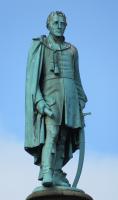
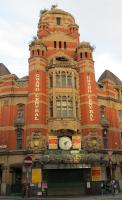
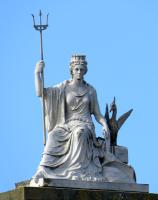
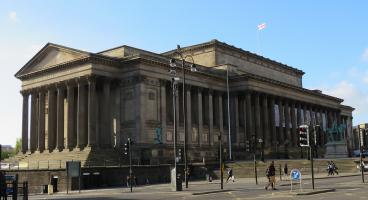
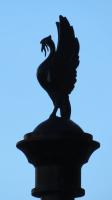
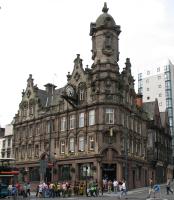
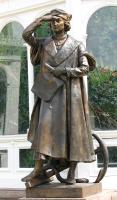
As one of the great Victorian cities, built on manufacturing prowess and civic pride, Liverpool is enriched with many statues and much other sculpture. The most significant groups of statues cluster around St George’s Hall. On the steps in front towards Lime Street Station, we find the equestrian portrait statues of Queen Victoria and Prince Albert, a fine Disraeli, and General Earle, alongside beautiful architectural sculpture on St George’s Hall itself, and nearby are Wellington on his column, the Steble Fountain with Greek gods and goddesses, stone lions and mermaids and tritons, and the more modern Liverpool Cenotaph.
Round the other side of St George’s Hall in St John's Gardens statues, free-standing statues are numerous – Gladstone, Rathbone, several other important civic figures, and the Liverpool Regiment Monument. The Liverpool Queen Victoria Memorial is one of the most important in the country, and stands in Derby Square. Exchange Flags, behind the Town Hall, contains Liverpool’s Nelson monument, a grand pyramidal composition, and the first of the city’s significant set piece sculptures, having been emplaced in 1813. Not so far off is Monument Place, where stands another equestrian Statue, to George III.
The 19th Century spans both Classical and Gothic, and sculpture belonging to both sorts of building abounds in Liverpool. Several of the Liverpool streets have large amounts of decorative architectural sculpture on the large and small scale, much of the highest quality. One of the most excellent is Castle Street (mostly Classical), which has a page on this website, and includes as well a building with extensive architectural mosaic decoration. Another such street is Dale Street, where the Municipal Buildings (Classical tending to a bit Gothic) can be found, with no less than 16 allegorical statues.
The symbol of Liverpool is of course the Liver Bird, and there is a page about these here – apart from the famous ones on the Liver Building, there are many small ones scattered across the city.
Church monuments are much beloved of this website, but Liverpool churches and the Cathedral were either bombed or too late to have much in this line. One of the bombed churches, surviving as a noble Gothic ruin, is St Luke's Church, Berry Street.
Sculpture pages // Statues in English towns
Visits to this page from 6 Oct 2017: 6,515